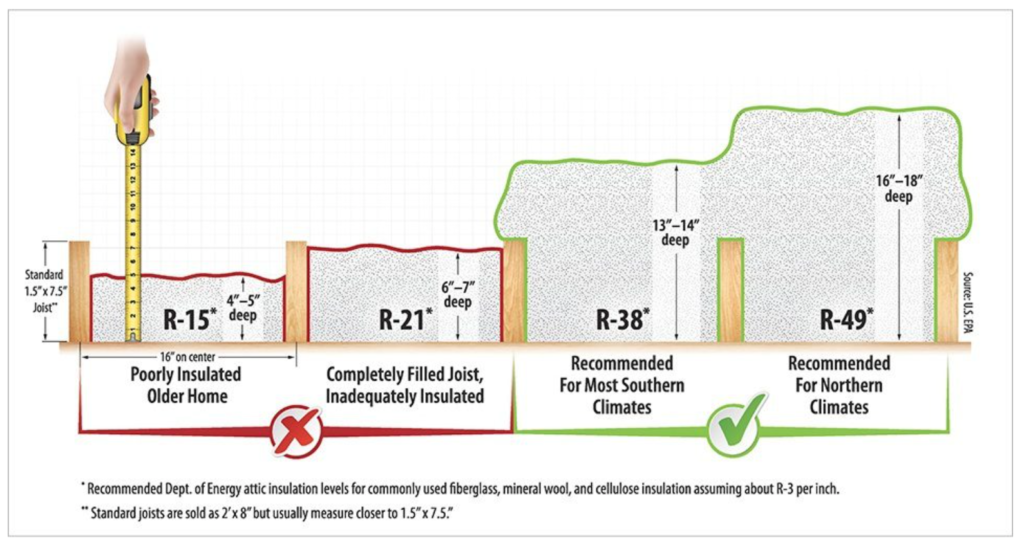Whether you are preparing to sell your home and want to improve your energy score, or you are looking for ways to save on utility costs, upgrading your home’s insulation is one of the best places to start. Insulation is by far one of the most influential factors in a home energy score rating, and fortunately, insulating your attic is also one of the easiest ways to improve your score.
Determine Your Insulation Needs
The first step is to evaluate the current level of insulation in your attic. This can easily be done visually by comparing the height of the existing insulation against the floor joists in your attic. If the level of insulation is at or below the level of the floor joists, you should add another layer. If the floor joists are completely covered by insulation, your attic is probably already well-insulated. Also check for an even distribution of materials from the center of the attic all the way to the eaves, with no low spots that could compromise the performance of your insulation.

Check Your Roof for Potential Air Leaks
Once you decide to add insulation, it is important to assess your attic for possible air leaks. This way you can find and repair any gaps that could possibly leak air to prevent future structural damage before adding insulation. The purpose of attic insulation is to prevent heat from escaping living spaces while keeping the attic cold and dry. However, insulation doesn’t prevent warm air and moisture from escaping through unsealed cracks, chimneys, roof vents or windows. These air leaks can be especially problematic in the winter, as warm air melts snow and ice, causing water to seep back into the roof. When it comes to energy scoring, a home performs well when both heat and air are controlled.
Choose the Best Insulation Material for Your Attic
When choosing insulation, consider the R-Value, which is a number that measures the material’s ability to resist heat flow. Higher R-Values correspond to better thermal insulating properties. A level of R-38 is recommended for most attics and will measure around 10 to 14 inches, depending on the type of insulation used. Portland’s climate specifically requires an attic insulation level of R-38 to R-60, based on recommendations from the U.S. Department of Energy (DOE). If you found that the existing insulation in your attic was low, you can simply add another layer, as R-Values have a cumulative effect. For example, if the current level of insulation is R-18, you need a layer of R-20 to achieve a total value of R-38. There are many different kinds of insulation materials to choose from, and from a budget perspective, those with higher R-Values typically cost more. Let’s examine the types of insulation most commonly used in the attic and the pros and cons of each.
- Fiberglass insulation is one of the most commonly used types of insulation for all areas of the home, including the attic. It is made from glass fibers that are spun into fine threads and either left loose or compressed into batts. Fiberglass insulation is relatively low cost, easy to install (in batting form) for homeowners who want to apply it themselves, and resistant to moisture. However, it is less effective at insulating the attic than other materials and can be irritating to the skin and respiratory system if inhaled. Wool insulation also comes in roll or batting form and is made from natural sheep wool fibers. As a more environmentally friendly alternative to fiberglass, it is also effective at insulating against both heat loss and air leaks. Wool is a sustainable option as it is both renewable and biodegradable. The additional benefits of wool as an insulation material are its natural fire-resistance and excellent soundproofing properties.
- Cellulose insulation is made from recycled paper and is usually blown into place by a professional, though it is possible to do it yourself with the rental of a blowing machine. Cellulose is sometimes also treated with borate, which is relatively harmless to people and pets and makes the material pest- and fire-resistant. It is more effective at insulating against air leaks than fiberglass and is less irritating if inhaled, though it generates dust when blown in to attic spaces. Cellulose insulation can have a higher price tag than loose fiberglass fill and has a tendency to settle over time, which can lower its insulating ability. (A helpful way to offset this loss is to install extra cellulose initially.) An alternative to cellulose insulation that can also be blown in to attic spaces is recycled denim insulation, which is very effective at insulating against heat loss and also does not contain any irritants.
- Spray foam insulation is usually made from polyurethane and professionally applied as a liquid that slowly expands to fill a space. It is the most effective type of insulation at insulating against air leaks, and as an additional benefit it can also help to strengthen the structure of your home. At the same time, spray foam insulation tends to be the most expensive type of insulation and can be difficult to install yourself. Another big downside of this material is the off-gassing of toxic chemicals when it is applied. The good news is that some spray foam manufacturers are starting to use soybean oil as an eco friendly alternative to petroleum-based polyurethane foam that achieves the same insulating benefits, minus the harmful fumes.
- Radiant barrier insulation is made from reflective material that prevents downward heat flow from the attic in the summer and helps contain heat to living spaces in the winter. It is often used in addition to another type of insulation and can be effective at helping to reduce energy costs.
TIP: It is not necessary to use the same type of material when adding to existing insulation. Loose fill can be added to batting, and vice-versa. One caveat is that fiberglass batting added over loose fill should not have a paper or foil backing. For more types of insulation materials and their applications, check out this handy reference chart from Energy.gov.
Install Your New Attic Insulation
When evaluating your options for attic insulation it is important to take your specific needs into consideration, including any existing insulation in your attic, plus your budget and energy goals. And whether you decide to hire a professional to install your insulation or take a more do-it-yourself approach, the performance of insulation depends on how well it is installed. Be sure to seek out an experienced insulation contractor or make sure you are prepared with the knowledge and tools to perform a successful installation of your attic insulation. The Energy Star® website offers a useful diy reference manual for homeowners who are interested in learning how to effectively seal and insulate their homes.
Improve Your Home’s Energy Efficiency
If you have upgraded your attic insulation and are getting ready to sell, or want to discover more ways you can optimize your home’s energy use, learning your home energy score is incredibly useful. Along with the score, the report provides you with a helpful assessment of the most effective improvements you can make to improve your home’s energy efficiency. Schedule an appointment today!

